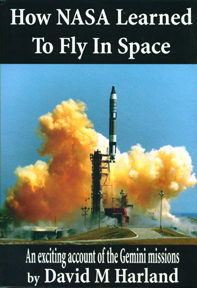 How NASA Learned to Fly in Space ISBN 9781894959070 $35.95 Canadian
| How NASA Learned To Fly In Space by David Harland Listen to The Space Show interview with David. NASA learned to fly in space in a time when the agency was young and lean, and had an explicit mandate of staggering audacity set against a tight deadline; in a time when the agency readily accepted risk, and made momentous decisions 'on the run'; in a time when a rendezvous was a major objective of a mission, in a time when opening the hatch and venturing outside was a serious challenge. Apollo claimed the glory, but it was Gemini that 'stretched the envelope' of spaceflight to make going to the Moon feasible. As Dr Robert Gilruth, director of the Manned Spacecraft Center in Houston, observed: "In order to go to the Moon, we had to learn how to operate in space. We had to learn how to manoeuvre with precision to rendezvous and to dock; to work outside in the hard vacuum of space; to endure long-duration in the weightless environment; and to learn how to make precise landings from orbital flight - that is where the Gemini Program came in." |